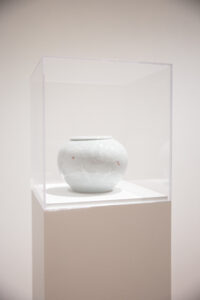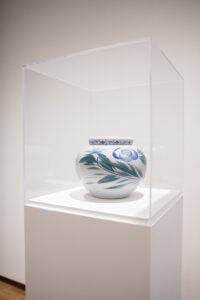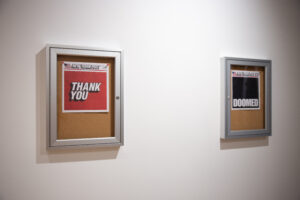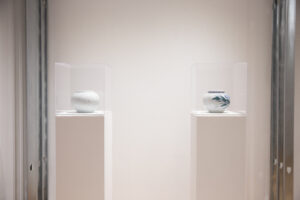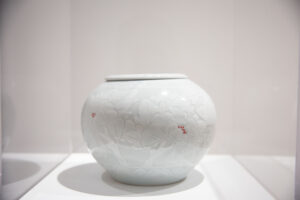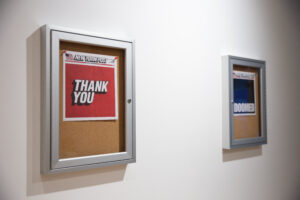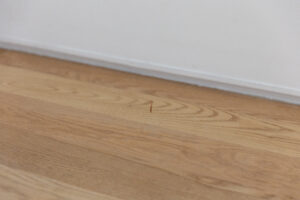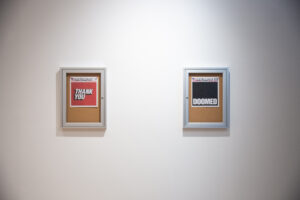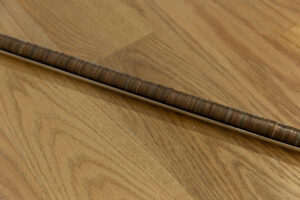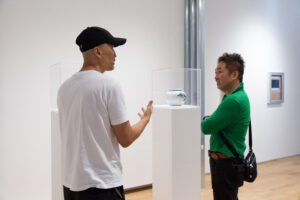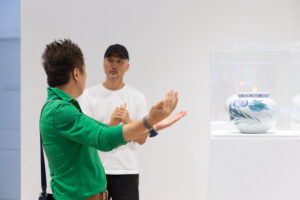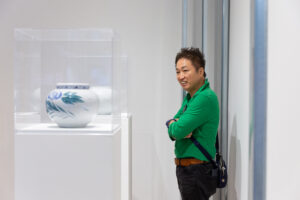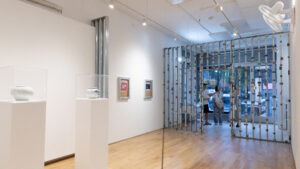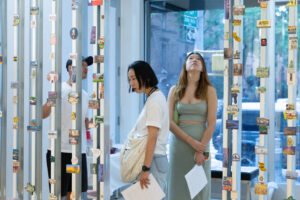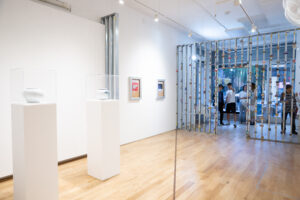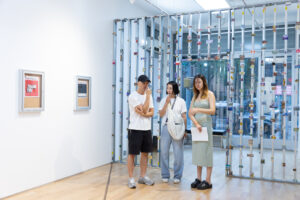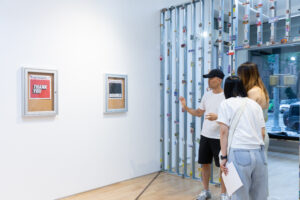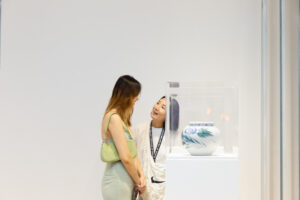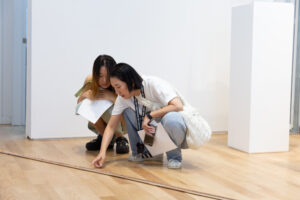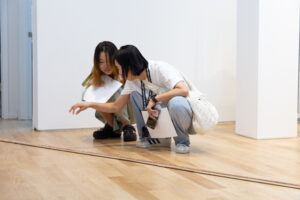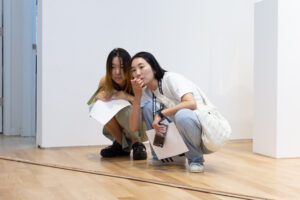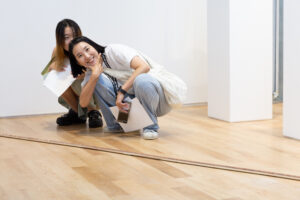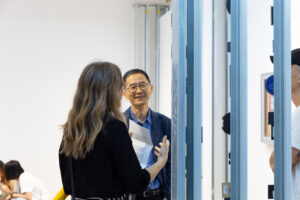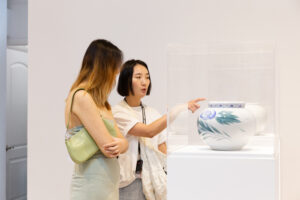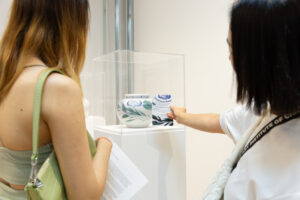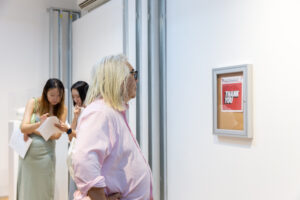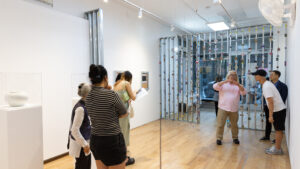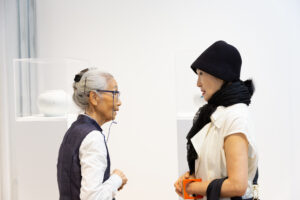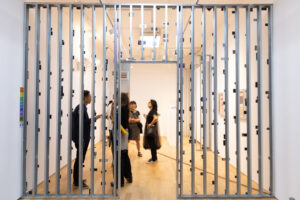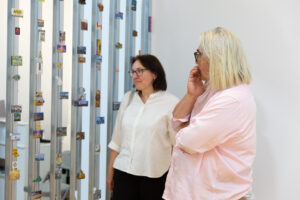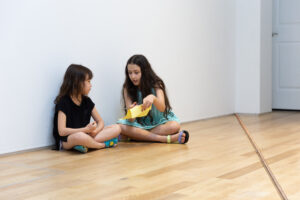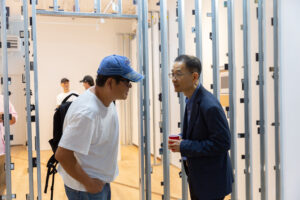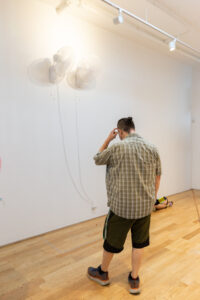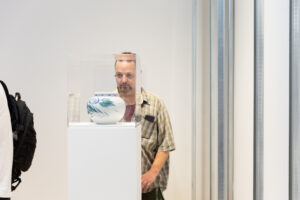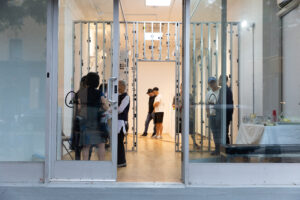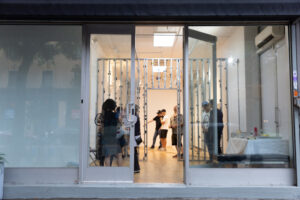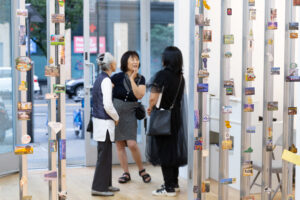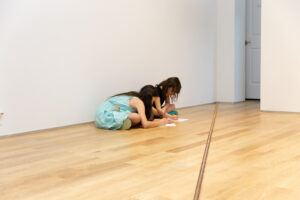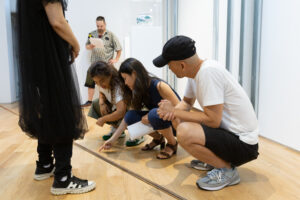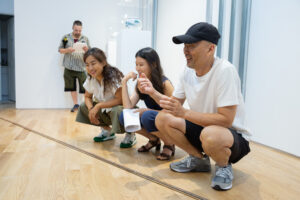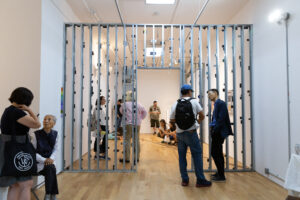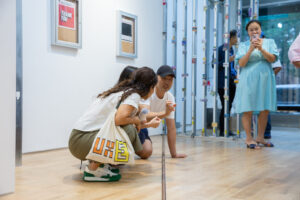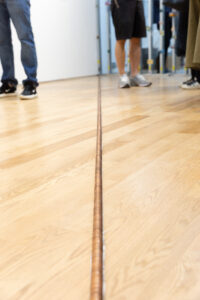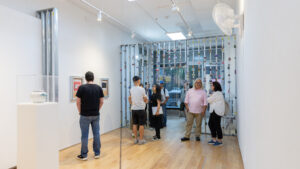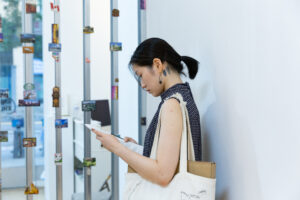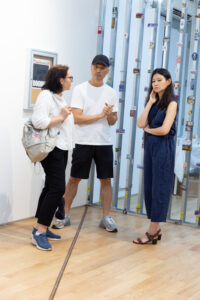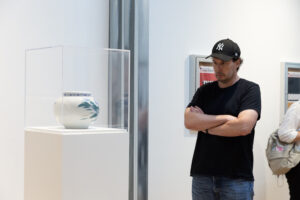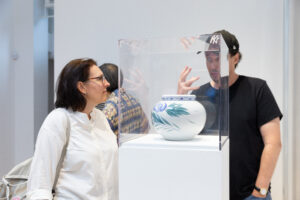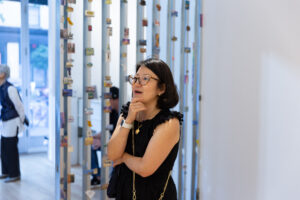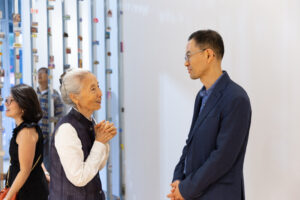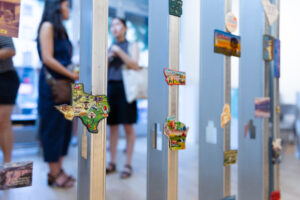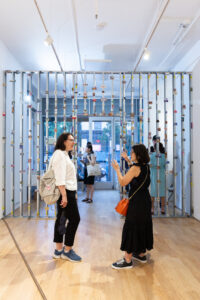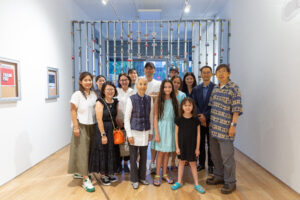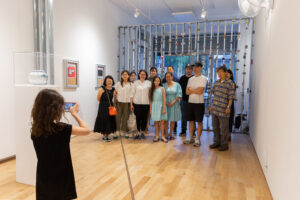Predicament Room
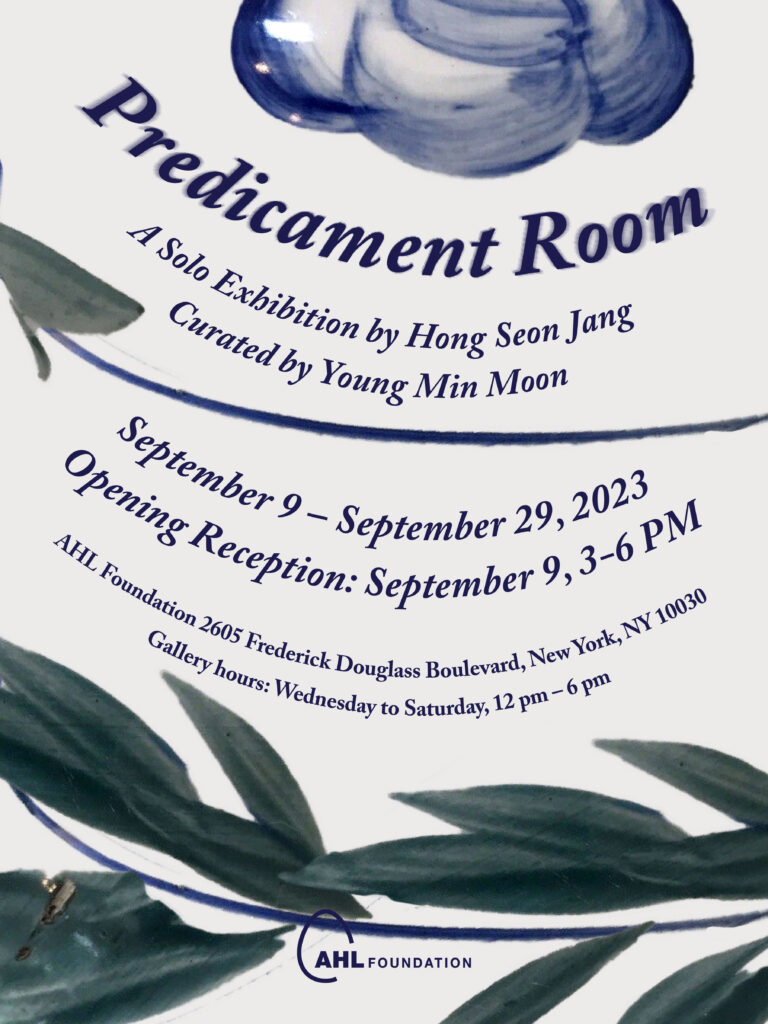
A Solo Exhibition by Hong Seon Jang
Curated by Young Min Moon
- Exhibition Dates: September 9 – September 29, 2023
- Opening Reception: September 9, 3-6 PM
- Venue: AHL Foundation (2605 Frederick Douglass Boulevard, New York, NY 10030)
- Gallery hours: Wednesday to Saturday, 12 pm – 6 pm
In Anticipation of an Everyday Reality1
Young Min Moon
In an episode of the famous sitcom Friends, two friends accompany Ross to an emergency room and try to enlist immediate medical help for his minor injury. After making a phone call to file a complaint about her dissatisfaction with a candy bar, an imposing receptionist orders them to sign in and sit tight. Stunned, one of Ross’ friends likens their situation to being in a predicament room, not an emergency room, only to be shut down again by the receptionist. The friends’ frustration does not last long as they eventually take an unintended but ‘sweet’ revenge on the receptionist. But in real life, sweet revenge is not always feasible, especially if you are a person of color in the U.S.
The New York-based artist Hong Seon Jang appropriated the expression Predicament Room as the title of his solo exhibition at the AHL Foundation Gallery in Harlem, referring to the perpetual state in which Asian Americans find themselves. Perhaps in substantial ways he has not done previously, Jang grapples with the discomforts of his lived experience to explore the state of Asian American identity, which is “a muted subject” in the racially and politically polarized American society. Racial discourse in America is often conducted in the binary of black and white.
Whatever happened to anti-Asian sentiments in this country? The victims of the Atlanta massage parlor massacre remain virtually unknown, unlike the victims of other mass shootings that make the headlines. Now that the pandemic has subsided, along with anti-Asian hate crimes, is it OK to simply move on? If another pandemic originates from Asia, will we expect a return of anti-Asian violence? That this exhibition is taking place in Harlem is poignant because, as Claire Jean Kim pointed out, mainstream white America was on a bandwagon to criticize anti-Asian hate crimes since they were suddenly relieved from discussing anti-Blackness for a change.2
As the poet and author Cathy Park Hong noted, Asian Americans are in a “vague purgatorial position” because they are at once aggressors and oppressed in the racial hierarchy in America. Because they are invisible, “the ways in which (they) are oppressed are never seen.”3 Through this exhibition, Jang recalls his oppressive upbringing in the militarized state of South Korea, acknowledges his aspirations and pressure to succeed as an immigrant, and grapples with his minor feelings as an Asian American. The exhibition attempts to reconcile the dissonance between his life experiences as an immigrant: alienation, indignity, and resentment, without losing hope, humor, and poetic vision.
Although the exhibition includes specific features of a typical house, such as security lights, decorative ceramic jars, and souvenir fridge magnets, it hardly offers a sense of home or comfort. Instead, it conjures what may be called an immigrant aesthetics, less in the sense of what immigrants might bring from their homeland than how particular material objects reflect how the dominant culture imprints on the immigrant’s psyche. The overall impact of the works is jarring, confrontational, and at times witty.
The Defiant Space
From the entrance, the viewers become self-conscious by the harsh light from a motion sensor-controlled lighting system that detects their movements. It is as though they become an intrusive presence in the artist’s private space: i.e., his consciousness. Nearby, Jang erected a wall using metal studs in a narrower interval than typical building code requirements, accentuating a sense of psychological barrier, a form of warning, and reinforcement to protect what might be hard-earned properties or to present particular objects of emotional ambivalence.
Inside the wall are two well-known front covers of the New York Post, each enclosed and locked in an institutional bulletin board case. One features the cover that declares DOOMED, with everything else blacked out. The original cover drew fierce criticism from left and right for its insensitivity and lack of empathy in publishing a photo of the drunken Korean male who was pushed to death from a New York subway platform in 2012. Little is known about the identity of the man. Although many problematized the journal’s sensationalism, I repeat: why make a spectacle of the impending doom of an Asian man in the NYC subway? Would they have published it if the doomed man was a white male? The image is deeply ingrained in the collective psyche of Asian Americans. The other cover, simply saying ‘Thank you,’ was a tribute to the first responders during the pandemic years but intentionally taken out of context to imply the artist’s ironic stance regarding the social expectation for immigrants to be grateful for their being in America.4
My America
Tucked behind the metal stud gate is a collection of hundreds of souvenir fridge magnets and other trinkets filling the wall. One has often seen fridge doors with dozens of magnets. Still, the collection presented here is excessive, verging on the ludicrous when thinking about the American obsession with souvenirs, an emblem of marking and marketing sites that once belonged to the indigenous peoples.
The question of authenticity has always afflicted souvenirs, especially now that most of the tacky memorabilia from all over the world is mass-produced in China. Jang raises questions about his relationship to the authenticity of his experience, or lack thereof, with the locations represented in them. If the premise of collecting keepsakes is to learn about oneself, Jang offers a collection of fridge magnets precisely because they do not speak much to him. It might be blunt, but more honest to say the magnets leave him cold. In contrast, people fondly recall happy memories as they contemplate their souvenir collections while sitting at home because they traveled to distant places: they went, saw, and “conquered the gift shop.”5 The vital marker that makes the kitsch objects precious but rarely mentioned is that collectors have a place of origin they can return to and call it home. The fact that Jang purchased most of the souvenirs from eBays at the click of the mouse indicates the lack of “authenticity” of having traveled and, by implication, the absence of the origin called home to cherish the distant places. Even though he is married to an American and lived in New York for over two decades, he has a nagging sense of whether he feels part of that American identity. Are there souvenirs that are more “authentic” than others?
Believing is Seeing
Installed on the floor and diagonally bisecting the gallery is Change, where tens of thousands of pennies are lined up tightly in half-exposed metal pipes slightly raised off the floor. The installation recalls a wide range of associations, such as money flow, oil and natural gas pipeline, and even the Dadaist John Heartfield’s photomontage of Adolf Hitler, where coins are ingested down his esophagus to fund his ethnic cleansing project. Change also recalls the Hollywood film Falling Down, starring Michael Douglas as a frustrated white male with anger management issues who violently vents at everyone he encounters. He first blows up at a Korean grocer who refuses to give changes for a payphone call unless he buys something, destroying the merchandise before leaving the store. In this film, coins represent the stereotype of hard work ethic, penny-pinching miserly attributes, and robotic qualities associated with Asian American immigrants.
For Jang, coins have a special place in his heart. He recounts his childhood memory of running an errand for his father, who gave him just enough money to get something but not more. On that scorching summer day, he craved an ice cream bar. Moments later, he stumbled upon a coin that was enough to buy himself a frozen dessert and take a bus home. Was this serendipity or a “meaningful coincidence”?
But after moving to the U.S., Jang found the pennies were everywhere. Its ubiquity testified to the common belief that it lacked value. The artist supposedly picked up the pennies whenever he saw one. Did he think the accumulation of pennies would eventually amount to a significant sum, as the Korean proverb goes about collecting dust to build a mountain? The artist eventually recognized that collecting pennies became an obsessive compulsion that revealed his success complex as an immigrant. Pennies may be worthless, but when made visible and lined up as in Change, they suddenly become bizarre, taking on a personified arrangement as in an oppressive military environment or even recalling the spectacular mass game in North Korea where individuality is subsumed under the collective identity.
Pennies contained within the linearity of the pipe also evoke single-minded pursuits or prescribed ways of channeling the resources, like the common tendency among first-generation Korean immigrants to sacrifice for their children.
The levitating penny under the two oscillating fans in Coincide recalls Carl Jung’s scarab, the dung beetle seen in his dream, which was then noticed in real life just when needed while he was counseling a woman who was armed with rational thinking. Often cited as an example of Jung’s synchronicity, what had been dreamed was shown in reality. With its tenuous and subtle movement of a penny,
Coincide may involve trickery. Still, it evokes his desire to relive the miraculous discovery from his childhood. Perhaps the coin began to exist for him when he believed he would find a coin and buy himself an ice cream.
Set against Coincide, all the pennies seem to be waiting in line to be freed from the lineup so each can get a chance to drag, dance, and get lifted by the fans. Meanwhile, the single levitating penny embodies the suspension of disbelief and eschews the rational mind to explain everything. Jang attempts a leap from reality: from the constraints of the immigrant experience to a flight of imagination where his childhood memory and wondrous magic of repetition and infinity overlap, producing a playful arrangement of an animated coin. Simultaneously, in so far as the floating penny is an illusion, it may be a wry commentary on the American dream as an illusion. An homage to the renowned conceptual artwork The Perfect Lovers by Felix Gonzalez-Torres, which is most understood as a celebration of the synchronicity of the artist and his lover dying of AIDS, Coincide could also be interpreted as a tribute to his family as a sacred space.
Crouching Tiger & Hidden Dragon, Reprised
The two Korean ceramic jars Jang presents in pristine condition, encased in Plexiglas, vaguely recall clay works from the Joseon Dynasty and celadons from the Koryo Dynasty. Asian ceramics are often associated with the notions of tradition, mastery, and high aesthetic standards, considered objects worthy of collection and appreciation, and embraced by the cultural elites. However, the two jars are mass-produced Yo-gaang, a container for urines temporarily collected overnight in premodern Korean houses where bathrooms were in an outhouse, away from the main structure that houses bedrooms. It was an object of convenience, especially in cold weather.
If Duchamp’s urinal posed a threat by elevating a recognizable urinal onto a pedestal, Jang’s urine pot acts as a decent cultured object that turns out to be an object of abomination, evoking disgust at the idea of keeping urine in the room. The discrepancy between the appearance of the urine pot as a beautiful ceramic object and what it actually is is relevant here.
Transposed in the context of the racial hierarchy of the U.S., does the urine pot perhaps signify the stereotype of Asian Americans’ silence, like a docile and virtuous person withstanding hardship and discrimination but brooding with minor feelings? As if armed with formidable prowess as the title Crouching Tiger & Hidden Dragon implies, the urine pots challenge the American viewers: Don’t just take them for their beauty, but can you take them for what they are? The urine pots embody the conflicting positions and ambivalent emotions of Asian Americans in their subordination to the racial and capital hierarchy while holding onto the promise of success. As Jia Tolentino observes in her reading of Cathy Park Hong’s Minor Feelings, “To be Asian-American…is to be tasked with making an injury inaccessible to the body that has been injured. It is to be pissed on at regular intervals while dutifully minimizing the odor of piss.”6 Indeed, Hong describes minor feelings as “that racialized range of emotions that you have because your reality is not acknowledged by the dominant culture.”7
The Remaining Questions
Many Korean immigrants’ recent wave of permanent return home to South Korea is undoubtedly related to their home country’s global ascent in technological and cultural advancement. But it also owes to the failed promise of the American dream and the dysfunction of American culture and political landscape in the U.S. Specifically, it is rooted in the sense of disillusionment of having led a life of perennial outsiders who are nonetheless expected to be grateful, hard-working, and well-behaved, thereby inadvertently fulfilling the myth of the model minority. Put more bluntly, perhaps they are fed up with selecAve tolerance bestowed upon them by the mainstream U.S. society: i.e., the ethnic foods, K-pop and dramas, and technological gadgets imported from South Korea are embraced, but the Korean immigrants largely remain perpetual foreigners. Some choose to return home, but most are here to stay, grappling with ongoing anticipation of their day-to-day realities of racism, the less-than-spectacular events of microaggressions that the mainstream American society constantly gaslight and negate: “It’s all in your head.”
Hong Seon Jang recalls his experience of being questioned by a stranger, a white woman, in the New York subway about his identity while being a father with his blue-eyed daughter: The stranger asked Jang, “Who are you?” as though the stranger was protective of Jang’s daughter because she looked white, but Jang did not. Having had “minor feelings” from such disturbing encounters, I reckon Cathy Park Hong’s intention to write her book resonated with him. Regarding her daughter, Hong determines,
I wanted her to grow up in a different world, a different kind of paradigm, where she didn’t take up apologetic space, where she didn’t feel uncomfortable in the skin that she was in, where she felt that everything was within her reach, and also for her to be sensitive to the struggles of others. 8
Hong voices defiance: “SomeAmes you just have to push back – being offended is part of the process.”9 Likewise, Hong Seon Jang’s immigrant aesthetics is that of resistance. Engaging with the legacy of conceptual art for critical ends, he refuses to remain silent and offers both concrete and emblematic intervention toward more democratic futures. The point is not to merely dwell in Asian victimhood but to seek solidarity among the oppressed and to fight for a more equitable country. The questions remain: “How are we also complicit in this white supremacist and capitalist structure? How do we also eradicate anA-Blackness in our culture as well? And how can we work as allies to bring social justice?10
1 For this essay’s title, I borrowed Cathy Park Hong’s words in her interview: “Depictions of exceptional racial trauma can sometimes suggest to readers that racism itself is extraordinary and rare, and not an everyday reality for millions of people. … Most Americans can only understand racial trauma as spectacle. What’s not represented enough is the constant stress of its anticipation.” Joe Fassler, “What Stories about Racial Trauma Leave Out,”, The Atlantic, Feb. 26, 2020. https://www.theatlanAc.com/culture/archive/2020/02/cathy-park-hong-susan-sontag/607081/
2 Weishun Lu, “Framing Asian Suffering in an Anti-Black World: A Conversation with Claire Jean Kim,”
Edgeeffects, Oct. 10, 2022. https://edgeeffects.net/claire-jean-kim/
3 Jia Tolentino, “Minor Feelings” and the Possibilities of Asian-American Identity,” The New Yorker, Mar. 6, 2020.
4 Many of the first responders were supposedly ambivalent about the public’s expression of gratitude because they felt conflicted about risking their lives.
5 Amelia Tait, “Tourist trappings: why we all love a tacky souvenir fridge magnet,” The Guardian, Oct. 30, 2022. https://www.theguardian.com/lifeandstyle/2022/oct/30/tourist-trappings-why-do-we-all-love-a- tacky-souvenir-magnet
6 Tolentino, ibid.
7 Nicole Clark, Interview with Cathy Park Hong, “Sometimes you just have to push back – being offended is part of the process.” Salon, Feb. 20, 2020. https://www.salon.com/2020/02/25/minor-feelings-cathy- park-hong-asian-american-reckoning-book/
8 Kara Swisher, Interview with Cathy Park Hong, “An Asian American Poet on Refusing to Take Up “Apologetic Space,” The New York Times, Apr. 1, 2021. https://www.nyAmes.com/2021/04/01/opinion/sway-kara-swisher-cathy-park-hong.html
9 Clark, ibid.
10 Ibid.

